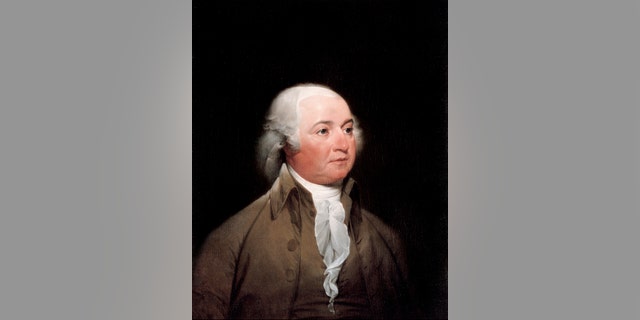President John Adams moved the federal government from Philadelphia to Washington, D.C., on this day in history, May 15, 1800.
The move was completed relatively quickly, according to History.com, with important documents brought to Washington by ships.
Adams had ordered his cabinet to ensure every office would be operating as usual in Washington, D.C., within one month, noted the same source.
ON THIS DAY IN HISTORY, MAY 14, 1973, SKYLAB, THE FIRST US SPACE STATION, IS LAUNCHED
This happened as planned — and Philadelphia “officially ceased to serve as the nation’s capital as of June 11, 1800.”
The move was swift due in part to the small size of the federal government at that period in time.

President John Adams ordered his cabinet to move to Washington, D.C., on this day in history, May 15, 1800. (GraphicaArtis/Getty Images)
At the time, there were only about 125 people employed as federal employees, said the History Channel.
Today, the federal government employs over two million people, according to the Office of Personnel Management’s website.
ON THIS DAY IN HISTORY, APRIL 29, 2004, WORLD WAR II MEMORIAL OPENS IN WASHINGTON, D.C.: ‘STIRS MEMORIES’
On July 16, 1790, then-President George Washington signed the Residence Act, which established that a capital city would be built along the Potomac River, said the website of the Library of Congress.

The federal government began its move to Washington, D.C., on this day in history, May 15, 1800. The Capitol building was only about half finished by this point in history. (AP Photo/Patrick Semansky, File)
As the city had not yet been constructed, Philadelphia was declared a temporary capital city for a 10-year period.
Washington announced in a proclamation back on Jan. 24, 1791, the location of the capital now known as the District of Columbia.
ON THIS DAY IN HISTORY, APRIL 30, 1789, GEORGE WASHINGTON INAUGURATED AS FIRST US PRESIDENT
“They were thereby authorized and required, on the behalf of the said State, to cede to the Congress of the United States, any District in the said state, not exceeding Ten miles square, which the Congress might fix upon and accept for the Government of the United States,” said Washington in the proclamation.
ON THIS DAY IN HISTORY, JAN. 8, 1790, GEORGE WASHINGTON DELIVERS FIRST-EVER STATE OF THE UNION ADDRESS
In the proclamation, Washington explained where the District of Columbia would be located.
He articulated permissions to survey the land and create these boundaries.
Pierre-Charles L’Enfant, a French engineer, was tasked with designing and planning the new city, said the History Channel.

An engraving depicting then-future President John Adams as he greets King George III of England as U.S. ambassador to St. James’s Court in 1785. (Stock Montage/Getty Images)
Although the District of Columbia was officially the capital of the United States of America, many of its famous landmarks were still under construction at the time that the government moved in.
President Adams and his wife, Abigail Adams, didn’t move into what is now known as the White House until later in 1800, said the White House website. (When Adams and his wife, Abigail, first moved on June 3, they lived temporarily at Union Tavern in Georgetown.)
Only the Senate side of the building was complete in 1800.
Wrote Adams about the White House residence once he and his wife moved in, “I pray heaven to bestow the best of blessings on this house, and on all that shall hereafter inhabit it. May none but wise men ever rule under this roof!”
CLICK HERE TO GET THE FOX NEWS APP
The Capitol at first was also similarly unfinished.
Only the Senate side of the Capitol building was complete in 1800, says the website for the Capitol.
CLICK HERE TO SIGN UP FOR OUR LIFESTYLE NEWSLETTER
The House of Representatives’ portion of the building would not be finished until 1811, more than a decade later, said the site.
Nevertheless, on Nov. 17, 1800, the House convened for the first time at the Capitol, according to History.com. By that time, enough space had been completed to receive the Senate, the House, the Supreme Court and the Library of Congress at the new permanent site of the federal government.
